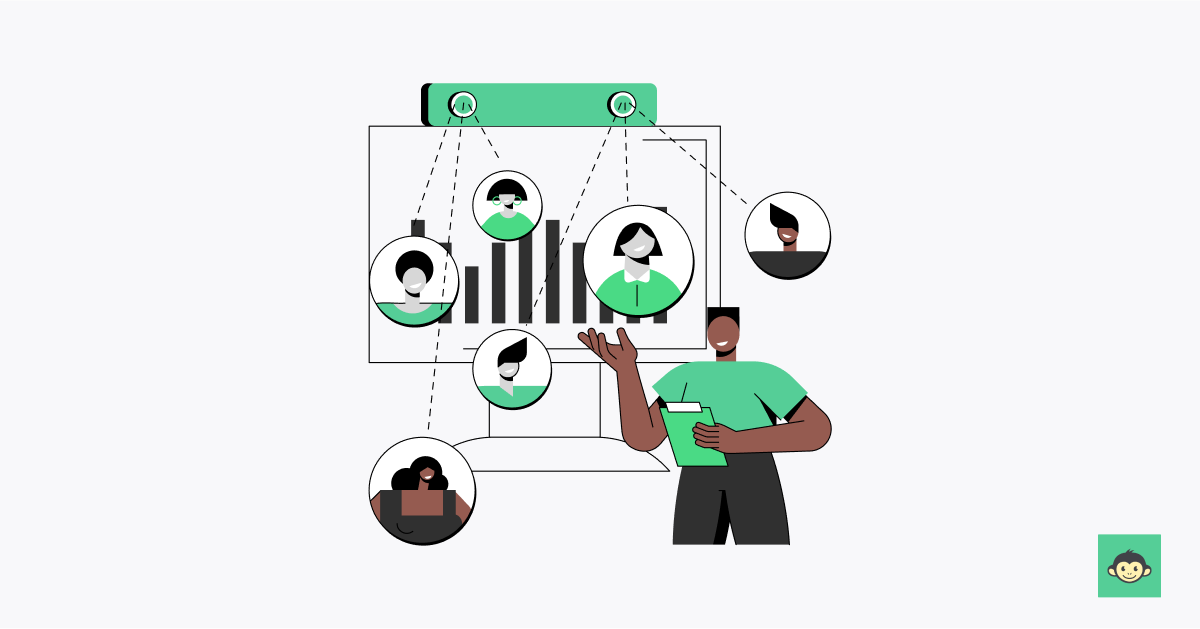Employee engagement survey strategy: A comprehensive guide

"Engaged employees are not just satisfied; they're inspired. They do more than punch the clock; they contribute their hearts and minds." - Ken Blanchard
Ken Blanchard couldn't have said it better!
A workplace is where employees are not just a cog in the machine but a superhero with a cape, and that happens when there is the magic of engagement. And right here, we have the spellbook you need—Employee engagement survey strategy.
We're not here to bore you with corporate jargon or drown you in mind-numbing statistics. Nope, we're all about the real talk, the nitty-gritty of making your workplace the kind of joint people brag about at family dinners.
So, grab your metaphorical popcorn, because we're about to spill the beans on the strategies that turn your employees from clock-watchers to cheerleaders.
What is the most effective way to measure employee engagement?

The question that often arises is, what is the most effective way to undertake this crucial assessment? Among various methods, the employee engagement survey stands out as a robust and comprehensive tool, uniquely equipped to unveil the pulse of an organization's workforce.
Employee engagement, defined as the emotional commitment an employee has toward their organization, is a multifaceted concept. Traditional methods such as performance appraisals and turnover rates provide valuable insights but fall short of capturing the nuanced facets of engagement.
One key advantage of the survey lies in its ability to generate quantitative data that is both reliable and measurable. The inclusion of standardized questions allows for consistent evaluation across different departments and levels within an organization.
This systematic approach facilitates the identification of trends, enabling employers to pinpoint areas of strength and weakness.
Beyond surveys, organizations often explore alternative methods to gauge employee engagement. These include:
1. 360-Degree feedback: Soliciting input from peers, subordinates, and supervisors offers a holistic perspective.
Limitation: It can be time-consuming and may introduce biases based on interpersonal relationships.
2. Exit interviews: Understanding reasons for departure can provide insights into engagement issues.
Limitation: By the time an employee leaves, it may be too late to address concerns effectively.
3. Attendance and punctuality: Consistent attendance patterns can indicate a sense of commitment.
Limitation: It may not capture the emotional aspects of engagement.
4. Focus group discussions: Engaging employees in group discussions fosters qualitative insights into their perspectives, allowing for a deeper understanding of sentiments.
Limitation: The sample size may be limited, and outspoken participants might dominate the conversation, potentially overshadowing the quieter voices.
5. Leadership and management feedback: Gathering feedback directly from leadership assesses the impact of managerial styles on employee engagement.
Limitation: Employees may hesitate to provide candid feedback, fearing repercussions or bias in their evaluations.
6. Innovation and idea generation platforms: Encouraging employees to contribute ideas and innovations gauges their level of commitment and involvement.
Limitation: The focus may be more on creativity and innovation rather than broader aspects of engagement, potentially missing underlying issues.
What is an employee engagement survey?
An employee engagement survey is a meticulously crafted instrument designed to gauge the emotional commitment, satisfaction, and overall connection employees have with their organization. This survey goes beyond conventional metrics, delving into the nuanced facets of workplace dynamics to provide a holistic understanding of employee sentiments.
Typically administered anonymously, these surveys encourage open and honest feedback, fostering an environment where employees feel comfortable expressing their views without fear of reprisal.
Comprising a series of standardized questions, the survey covers a spectrum of aspects, including job satisfaction, organizational culture, work-life balance, communication effectiveness, and professional development opportunities.
The structured nature of the employee engagement questionnaire allows for consistency in data collection, facilitating meaningful comparisons across different teams and departments within an organization.
The quantitative data generated from these surveys offers tangible levels for measuring employee engagement, enabling organizations to identify trends, strengths, and areas in need of improvement.
Furthermore, the employee engagement survey analysis serves as a powerful diagnostic tool, revealing crucial insights into potential areas of concern before they escalate.
Armed with this knowledge, organizations can proactively address issues, implement targeted interventions, and cultivate a workplace culture that not only attracts but also helps with employee retention.
What is the employee engagement survey method?

The employee engagement survey method is a systematic approach to evaluating the intricate fabric of organizational dynamics. Employing a structured questionnaire, this method seeks to quantify and qualify employees' emotional commitment and connection to their workplace.
The survey method, often administered anonymously, serves as a valuable tool for organizations to assess, understand, and enhance the overall engagement levels within their workforce.
The survey is typically composed of a carefully curated set of questions, strategically designed to capture insights into various dimensions of the employee experience. These dimensions may encompass job satisfaction, perceptions of leadership, alignment with organizational values, opportunities for professional growth, and the effectiveness of communication channels.
The method's strength lies in its ability to provide a standardized framework for data collection, ensuring consistency in evaluation across different departments, teams, and hierarchical levels.
Moreover, the employee engagement survey method is not a static instrument but an evolving one, capable of adapting to the changing dynamics of the workforce and organizational landscape.
Periodic administration of these surveys allows organizations to track trends over time, identify areas of improvement, and measure the effectiveness of implemented interventions.
The method thus becomes a dynamic feedback loop, enabling organizations to stay attuned to their employees' evolving needs and concerns.
What is the purpose of an employee engagement survey?

The purpose of an employee engagement survey analysis extends far beyond the realms of a routine workplace assessment. It serves as a strategic instrument, meticulously designed to unravel the intricate dynamics of employee satisfaction, commitment, and overall workplace morale.
Let's delve into the manifold purposes that underscore the significance of this invaluable tool:
- Measure job satisfaction: Gauge employees' contentment with their roles, responsibilities, and the overall work environment.
- Assess organizational alignment: Evaluate the degree to which employees connect with the organization's mission, values, and long-term objectives.
- Identify areas for improvement: Pinpoint specific aspects of the workplace experience that may require attention or enhancement.
- Enhance communication channels: Evaluate the effectiveness of communication within the organization and identify areas for improvement.
- Foster employee development: Understand employees' perceptions of professional growth opportunities and areas where skill development is desired.
- Boost employee morale: Uncover factors that contribute to or detract from employees' overall sense of well-being and job satisfaction.
- Evaluate leadership effectiveness: Assess the impact of leadership styles on employee engagement and satisfaction levels.
- Mitigate employee turnover: Identify factors that may contribute to employee dissatisfaction or potential turnover, allowing for proactive intervention.
- Enhance team collaboration: Understand the dynamics of teamwork and identify opportunities to foster a collaborative work culture.
- Promote work-life balance: Evaluate perceptions of work-life balance and identify strategies to support employees in achieving equilibrium.
- Drive organizational change: Provide insights that inform strategic decision-making and guide organizational change initiatives.
Employee engagement survey strategy benchmark data

The employee engagement survey strategy benchmark data is the compass that guides organizations toward optimal workforce engagement. It involves the systematic analysis of survey results against established benchmarks to ascertain how an organization's employee engagement levels measure up compared to industry standards or predefined goals.
This strategic utilization of benchmark data is paramount for organizations aiming to not only evaluate their current standing but also to chart a course for continuous improvement in employee engagement.
By leveraging benchmark data, organizations gain invaluable insights into the relative health of their workforce engagement. This comparative analysis provides context, allowing them to discern whether their engagement levels are above, below, or on par with industry benchmarks.
Analyzing top performers against benchmarks allows organizations to glean insights into successful engagement strategies, enabling them to adopt and adapt practices that have proven effective elsewhere.
This benchmark-driven approach transforms the survey results into actionable intelligence, empowering organizations to implement targeted initiatives that align with industry standards and elevate their workforce engagement.
The strategic use of benchmark data also serves as a vital tool for goal-setting. Organizations can establish realistic, data-driven targets for improving employee engagement, guided by insights derived from benchmark comparisons. This ensures that the strategies implemented are not arbitrary but tailored to meet or exceed industry norms.
Disadvantages of employee engagement surveys
While employee engagement surveys are invaluable tools for gauging workforce sentiment, they do come with a few inherent disadvantages. One notable drawback is the potential for survey fatigue.
Repeated administration of surveys, especially if not coupled with transparent communication regarding the purpose and outcomes, may lead to a decline in employee participation and authenticity of responses. If employees perceive the surveys as routine without tangible action resulting from their feedback, the efficacy of subsequent surveys may be compromised.
Additionally, the anonymity promised by these surveys, while fostering open feedback, can also pose challenges. In cases where the organization is relatively small, employees may fear that their responses could be deduced, limiting their willingness to express candid opinions.
Striking a balance between anonymity and providing meaningful insights that inform actionable changes can be a delicate task.
Despite these disadvantages, strategic survey design, clear communication about survey goals, and a commitment to acting on the feedback received can mitigate these challenges.
Organizations can leverage technology and innovative survey methodologies to address survey fatigue and foster a culture where employees feel confident in sharing their perspectives, ultimately enhancing the effectiveness of engagement surveys.
How an employee engagement survey helps you improve company culture?

An employee engagement survey is a powerful catalyst for enhancing and shaping a positive company culture. This strategic tool, when wielded effectively, serves as a compass, guiding organizations toward a culture that not only attracts top talent but also fosters a thriving and engaged workforce.
Here's how an employee engagement survey contributes to the continuous improvement of company culture:
- Identifies cultural strengths and weaknesses: By systematically gauging employee sentiments, engagement surveys unveil the cultural aspects that resonate positively and those that may need refinement. This clarity is pivotal in focusing improvement efforts where they matter most.
- Pinpoints areas for development: Through targeted questions, engagement surveys highlight specific areas requiring attention. Whether it's communication channels, leadership practices, or recognition programs, identifying these areas enables organizations to strategically develop and fortify cultural components.
- Strengthens leadership practices: Feedback gathered from engagement surveys provides insights into how leadership is perceived. This information allows organizations to refine leadership practices, ensuring they align with the cultural values and expectations of the workforce.
- Promotes open communication: The survey process itself fosters a culture of open communication. When employees perceive that their opinions are valued and acted upon, it encourages a transparent and communicative environment, a cornerstone of a healthy organizational culture.
- Aligns with employee values: Understanding the values that matter to employees is crucial for building a culture that resonates with them. Engagement surveys pinpoint these values, enabling organizations to align company culture with the intrinsic motivations of their workforce.
- Encourages employee involvement: The survey process itself is an opportunity for employees to actively participate in shaping the culture. When employees feel their input matters, it instills a sense of ownership and pride in the company's cultural evolution.
- Identifies barriers to collaboration: Collaboration is often a linchpin in a positive company culture. Engagement surveys shed light on any existing barriers to collaboration, allowing organizations to break down silos and create a more cohesive work environment.
- Shapes recognition and rewards programs: Recognizing and rewarding employees in line with cultural values is crucial for morale and engagement. Survey data guides the development of meaningful recognition programs that resonate with employees, contributing to a positive and appreciative culture.
- Supports continuous improvement: Perhaps most importantly, engagement surveys provide a mechanism for continuous improvement. Regular surveys enable organizations to track progress, assess the impact of implemented initiatives, and refine strategies, ensuring that the company culture remains dynamic and responsive to evolving employee needs.
Employee engagement and higher profits
Profitability boost (Source: Gallup)
Companies fostering high employee engagement witness a remarkable 21% increase in profitability. This correlation underscores the economic value of cultivating a workplace culture where employees feel connected and committed.
Global productivity drain (Source: Gallup's State of the Global Workplace: 2023 Report)
The cost of disengaged or actively disengaged employees is staggering – a staggering $8.8 trillion in lost productivity, equivalent to 9% of the global GDP. This statistic emphasizes the global ramifications of neglecting employee engagement.
Underutilization of technology (Source: Gartner)
Surprisingly, only 16% of employers leverage technology to monitor employee engagement levels, according to Gartner. This highlights an untapped potential for organizations to harness tech tools in understanding and enhancing employee engagement.
Impact on productivity and efficiency (Source: Eagle Hill Consulting)
Eagle Hill Consulting's Workplace Culture Survey reveals a profound connection between workplace culture and productivity. A substantial 76% of employees recognize the direct impact of culture on productivity and efficiency, emphasizing the need for a positive and supportive work environment.
Managerial support (Source: Staples Workplace Survey)
The Staples Workplace Survey 2019 delivers a wake-up call – a significant 68% of employees feel unsupported by management. This stark finding underscores the pivotal role leadership plays in fostering employee engagement, urging companies to prioritize managerial support to boost workplace morale.
These statistics collectively emphasize the imperative for organizations to invest in strategies that enhance employee engagement, from leveraging technology for insights to fortifying leadership support.
How to develop an employee engagement survey?

Developing an effective employee engagement survey requires a thoughtful and strategic approach to ensure meaningful insights. Here's the step-by-step guide every organization should consider while crafting and conducting employee engagement surveys:
- Define survey objectives: Clearly articulate the objectives of the survey. Whether it's assessing overall job satisfaction, identifying areas for improvement, or gauging alignment with organizational values, having a precise focus ensures that the survey is purposeful and yields actionable data.
- Select appropriate survey tools: Choose employee engagement survey software that aligns with the survey's goals and the preferences of your workforce. Whether it's online platforms or a combination, selecting the right tools ensures accessibility and ease of participation.
- Craft well-designed questions: Formulate questions that are clear, concise, and directly related to the survey objectives. Use a mix of closed-ended and open-ended questions to gather both quantitative data and qualitative insights. Questions should cover various dimensions of engagement, such as job satisfaction, communication, and professional development.
- Ensure anonymity and confidentiality: Communicate to employees that their responses will be anonymous, fostering open and honest feedback. Guaranteeing confidentiality is crucial for creating a safe space for employees to express their opinions without fear of repercussions.
- Pilot test the survey: Before launching the survey organization-wide, conduct a pilot test with a small group of employees. This helps identify any ambiguous or confusing questions, ensuring that the final survey is clear and effectively captures the intended information.
- Determine frequency and timing: Decide on the frequency of the survey. Regular employee engagement surveys measure a longitudinal view of engagement trends, while occasional deep dives may be appropriate for specific initiatives. Consider timing to avoid survey fatigue and select moments when employees can dedicate focused attention.
- Communicate results and take action: After collecting and analyzing the survey data, communicate the employee survey results transparently. Acknowledge areas of strength and highlight specific actions that will be taken to address identified challenges. The key is not just in data collection but in the proactive use of insights to drive positive changes within the organization.
10 Employee engagement survey strategy examples

Crafting an effective employee engagement survey strategy is essential for organizations seeking to elevate workplace morale and foster a culture of continuous improvement. Let's explore ten strategy examples that showcase innovative approaches to conduct employee engagement surveys:
1. Customization for diversity
Recognize the diversity within your workforce and tailor survey questions to reflect the unique experiences of different departments, teams, and roles. This customization ensures that the survey captures the nuanced aspects of engagement across the organization.
2. Pulse surveys for real-time insights
Supplement traditional annual surveys with pulse surveys conducted at regular intervals. These quick check-ins provide real-time insights into employee sentiment, allowing organizations to address emerging issues promptly.
3. Inclusion of Employee Resource Groups (ERGs)
Involve Employee Resource Groups, representing various demographics or interests, in the survey strategy. This ensures that the survey addresses the specific concerns and aspirations of different employee groups, promoting inclusivity.
4. Leadership roundtable discussions
Augment survey data with leadership roundtable discussions. These forums provide an opportunity for executives to engage directly with employees, deepening their understanding of employee engagement survey results and fostering open dialogue.
5. Anonymous town hall meetings
Organize town hall meetings where employees can discuss survey findings anonymously. This platform encourages open communication, allowing employees to express concerns without fear of identification.
6. Post-survey action planning workshops
Conduct an employee engagement workshop post-survey to collaboratively develop action plans. Engaging employees in the process of addressing identified issues enhances their sense of ownership and commitment to the improvement initiatives.
7. Utilization of Artificial Intelligence (AI)
Integrate AI tools to analyze survey data. AI algorithms can identify patterns, correlations, and trends in responses, providing deeper insights into the factors influencing employee engagement.
8. Interactive data dashboards
Create interactive dashboards that visually represent survey data. This user-friendly approach enables leaders and employees to explore data dynamically, facilitating a deeper understanding of engagement metrics.
9. Mobile-friendly surveys
Ensure that surveys are accessible via mobile devices. This accommodates the modern workforce's preferences for flexibility and convenience, increasing participation rates.
10. Gamification of surveys
Infuse an element of gamification into the survey process. This can include reward systems, leaderboards, or interactive elements that make the survey-taking experience more engaging and enjoyable for employees.
Understanding engagement questions vs employee feedback questions
Distinguishing between engagement questions and employee feedback questions is critical for organizations aiming to cultivate a comprehensive understanding of their workforce dynamics.
While both types of questions are integral to the success of employee surveys, they serve distinct purposes and capture different dimensions of the employee experience. Here are eight points to clarify the nuances between engagement and employee feedback questions:
- Focus on emotional connection (Engagement questions): Engagement questions delve into the emotional commitment and connection employees have with their work and the organization. These questions aim to gauge the depth of employees' investment in their roles and their alignment with the company's mission and values.
- Assessing perceptions and experiences (Feedback questions): Employee feedback questions, on the other hand, seek to elicit perceptions and experiences related to specific aspects of the workplace. These questions are more targeted, addressing factors such as communication effectiveness, leadership practices, and the work environment.
- Quantitative vs. qualitative (Engagement questions): Engagement questions often lend themselves to quantitative analysis. Responses are measured on scales, providing numerical data that allows for benchmarking, trend analysis, and a broad overview of the organization's engagement levels.
- Actionable insights for improvement (Feedback questions): Employee feedback questions, while still quantifiable, often provide more qualitative insights. They aim to uncover specific issues or areas of improvement, offering organizations actionable feedback for targeted interventions.
- Broader organizational overview (Engagement questions): Engagement questions typically offer a high-level view of the organization's overall health and the general sentiment of its workforce. These questions contribute to strategic decision-making by providing a broad understanding of the factors influencing employee engagement.
- Targeted intervention and resolution (Feedback questions): Employee feedback questions are designed to pinpoint challenges or opportunities within specific organizational facets. This detailed focus allows leaders to address issues at a granular level, implementing tailored interventions to enhance the employee experience.
- Longitudinal analysis (Engagement questions): Engagement questions, when consistently used over time, facilitate longitudinal analysis. This approach enables organizations to track trends in engagement levels, identifying patterns and evaluating the impact of implemented initiatives over the years.
- Balancing big picture and detail (Both): A well-crafted survey strikes a balance between engagement questions that provide a holistic organizational overview and employee feedback questions that offer detailed insights. This comprehensive approach ensures that organizations have both a panoramic view and a nuanced understanding of their workforce dynamics.
Examples of poor employee engagement survey questions

Creating effective employee survey questions is crucial for obtaining meaningful insights. However, certain question formulations can inadvertently lead to ambiguity, bias, or unhelpful data. Here are ten examples of poor employee engagement survey questions and why they are considered suboptimal:
- Are you satisfied with your job? - This question is overly broad and lacks specificity. It doesn't address the specific aspects contributing to job satisfaction, making it challenging to derive actionable insights.
- Do you feel like your opinions matter at work? - The question is leading and may influence respondents to answer positively, as it implies that their opinions should matter. A more neutral formulation would elicit more genuine responses.
- Is your manager a good leader? - This question is subjective and does not define what constitutes a "good leader." It lacks specificity, making it difficult to derive meaningful insights about leadership effectiveness.
- Do you think the company is doing well financially? - Employees may lack the necessary financial information to answer accurately. It's better to focus on their perceptions of the company's stability and future prospects.
- Are you happy with the coffee in the breakroom? - Irrelevant questions like this one may distract from the survey's primary purpose, diluting the focus on factors directly related to employee engagement.
- Are you planning to leave the company in the next year? - This question may inadvertently plant the idea of leaving in the minds of employees who hadn't considered it before, potentially skewing the survey results.
- Does your workload stress you out? - The question is leading and assumes that the workload is stressful. A better approach would be to inquire about specific aspects of the workload and their impact on stress levels.
- Are you satisfied with the office temperature? - Similar to the coffee question, this one focuses on a minor aspect that may not significantly contribute to overall engagement or satisfaction.
- Do you feel valued as an employee? - The question is vague and lacks specificity. Employees may interpret "value" differently, making it challenging to pinpoint areas for improvement.
- Do you enjoy team-building activities organized by the company? - This question assumes that all team-building activities are enjoyable. A more effective approach would be to inquire about specific activities and their impact on team dynamics.
What are good questions for an employee engagement survey in 2024?
Designing effective questions for an employee engagement survey is pivotal for obtaining insightful and actionable feedback. The following 24 questions are strategically crafted to cover various dimensions of the employee experience, providing a comprehensive view of engagement levels within an organization:
- Job satisfaction: How satisfied are you with your current role and responsibilities?
- Organizational commitment: How connected do you feel to the mission and values of the organization?
- Communication effectiveness: To what extent do you feel heard and understood by leadership?
- Leadership impact: How would you rate the effectiveness of your immediate supervisor in supporting your professional growth?
- Workplace culture: How would you describe the prevailing culture within the organization?
- Professional development opportunities: Are you satisfied with the opportunities for professional growth provided by the organization?
- Work-life balance: How well does the organization support your efforts to maintain a healthy work-life balance?
- Team dynamics: How would you describe the level of collaboration and teamwork within your department?
- Recognition and appreciation: Does the organization effectively acknowledge and celebrate employee achievements?
- Employee morale: On a scale of 1 to 10, how would you rate your overall job satisfaction?
- Alignment with organizational values: To what extent do you feel your personal values align with the values of the organization?
- Job clarity and role perception: How clear are you about your role and responsibilities within the organization?
- Feedback mechanisms: Do you feel comfortable providing upward feedback to your supervisor?
- Inclusivity and diversity: How well do you think the organization promotes equal opportunities for all employees?
- Innovation and creativity: How encouraged do you feel to bring forth new ideas and suggestions?
- Training and development opportunities: Are you satisfied with the training programs provided for skill development?
- Workplace environment: How comfortable do you feel in the physical workspace provided by the organization?
- Job security: To what extent does the organization communicate about its financial health and stability?
- Employee wellbeing programs: Are you aware of and do you participate in any employee well-being programs?
- Performance recognition: How satisfied are you with the organization's approach to performance evaluations?
- Remote work satisfaction: Do you feel the organization values and trusts employees working remotely?
- Health and safety measures: Do you feel confident in the organization's response to health and safety concerns?
- Career growth opportunities: How transparent do you find the organization about potential career paths and advancement?
- Overall employee experience: On a scale of 1 to 10, how would you rate your overall experience as an employee?
3 Factors to keep in mind when interpreting employee engagement survey responses

Interpreting employee engagement survey responses is a nuanced process that requires careful consideration of various factors to derive meaningful insights. Here are three key factors to keep in mind when deciphering the data:
1. Context matters
Understand the organizational context surrounding the survey. Factors such as recent organizational changes, industry trends, or external events can influence employee perceptions. For instance, during periods of significant change, initial survey responses may reflect uncertainty or anxiety. Recognizing the contextual backdrop ensures that interpretations are grounded in a broader understanding of the organizational landscape.
2. Segmentation for precision
Analyze survey responses by segmenting data based on factors such as department, tenure, or job role. Different segments may exhibit distinct patterns of engagement, and a one-size-fits-all approach to interpretation may overlook critical nuances. By drilling down into specific segments, organizations can tailor interventions to address the unique needs of different employee groups.
3. Trends over time
Employee engagement is dynamic, and interpreting survey responses requires a longitudinal view. Comparing current results to historical data allows organizations to identify trends and patterns. Positive or negative shifts in engagement levels over time can signal the impact of implemented initiatives or highlight emerging issues that require attention. A snapshot view may miss the evolving nature of employee sentiment.
Conclusion
In the ever-evolving landscape of employee engagement, decoding survey responses is an art. Understanding context, delving into segmented data, and tracking trends over time are the keys to extracting actionable insights.
But why navigate this journey alone when CultureMonkey stands as the compass for organizational excellence? With its intuitive platform, CultureMonkey transforms the intricacies of employee feedback into a roadmap for growth.
From dynamic survey customization to real-time analytics, CultureMonkey empowers organizations to not just measure engagement but to actively shape a thriving workplace culture.
In the dance between survey responses and strategic action, CultureMonkey takes the lead, ensuring that your organization not only interprets employee engagement but orchestrates a symphony of continuous improvement.



